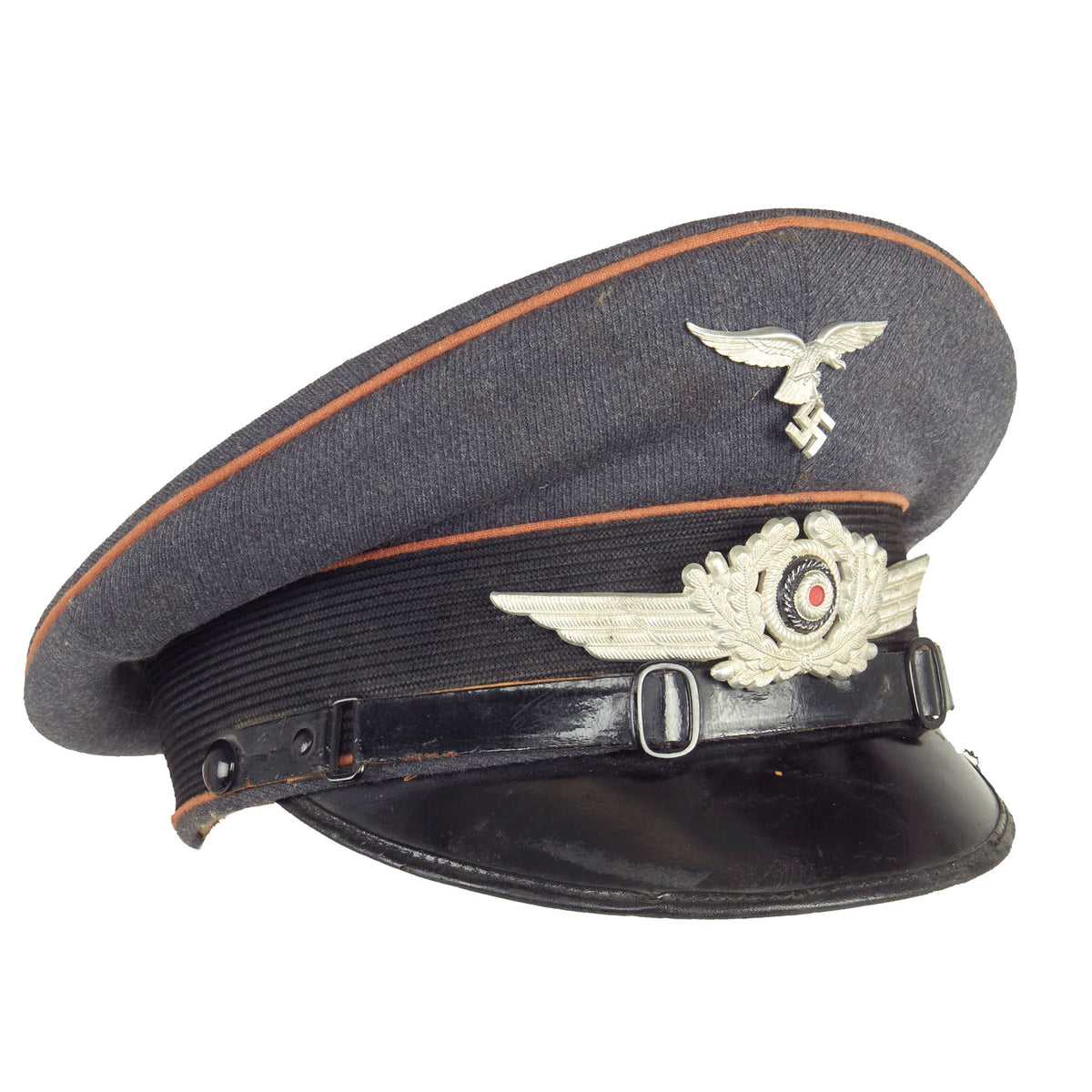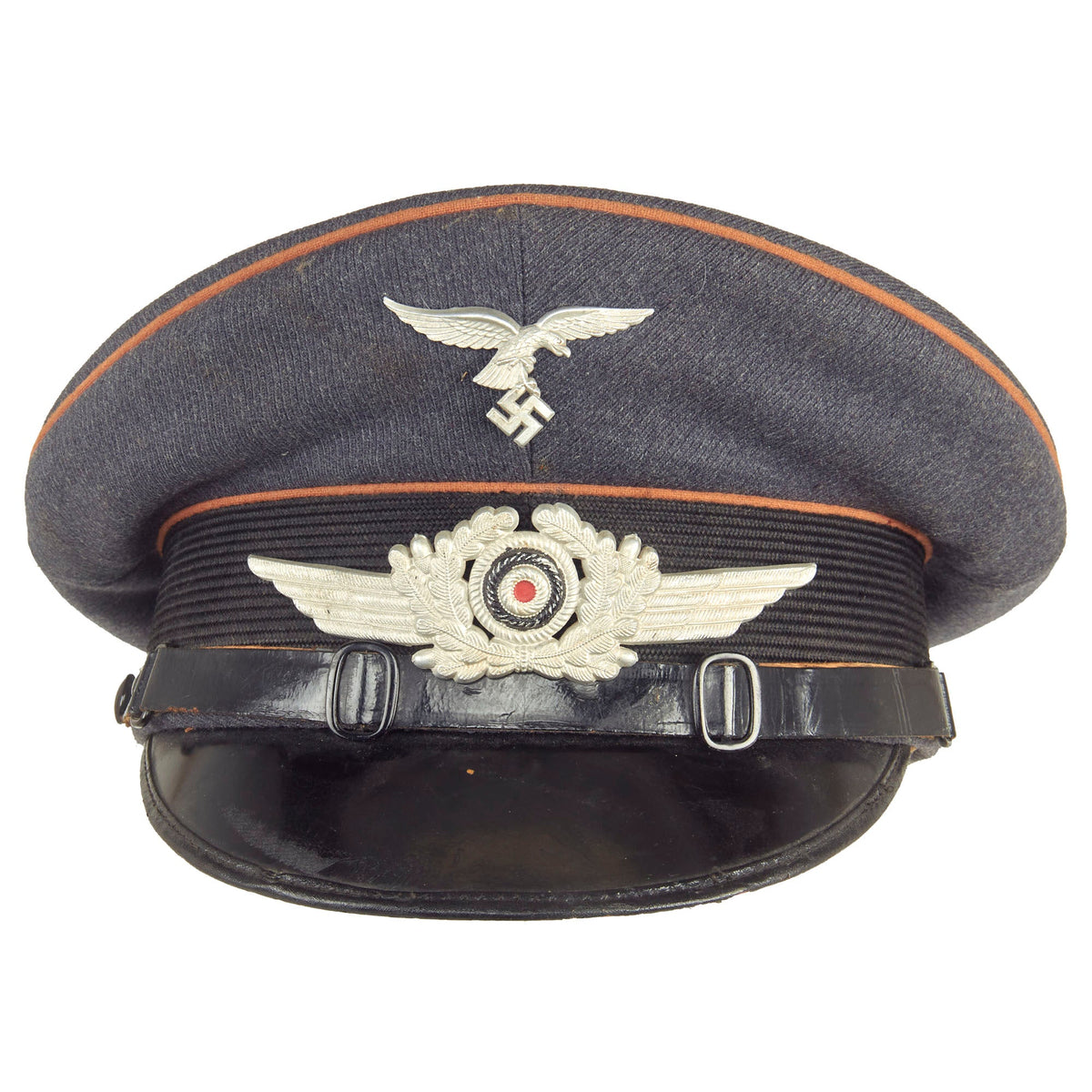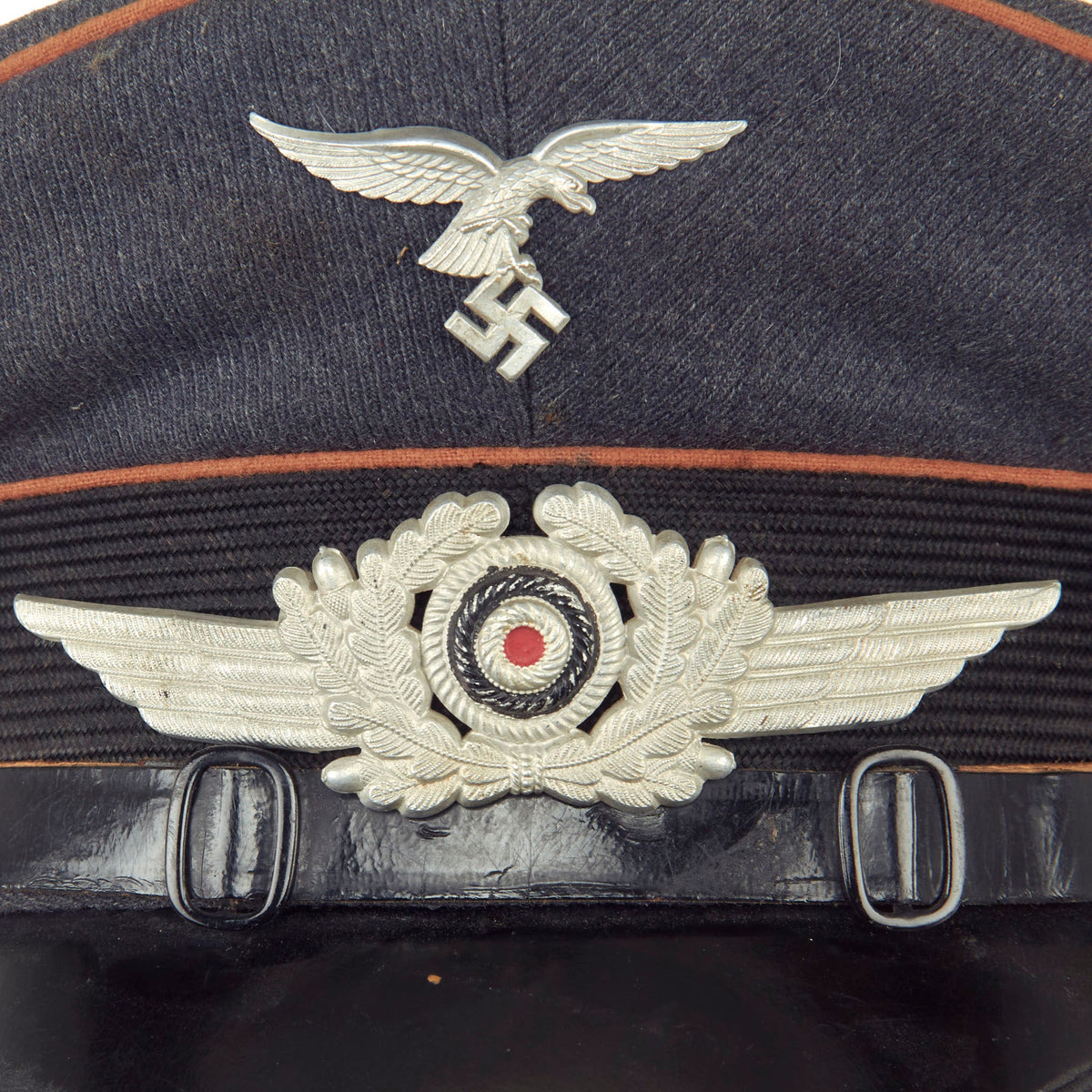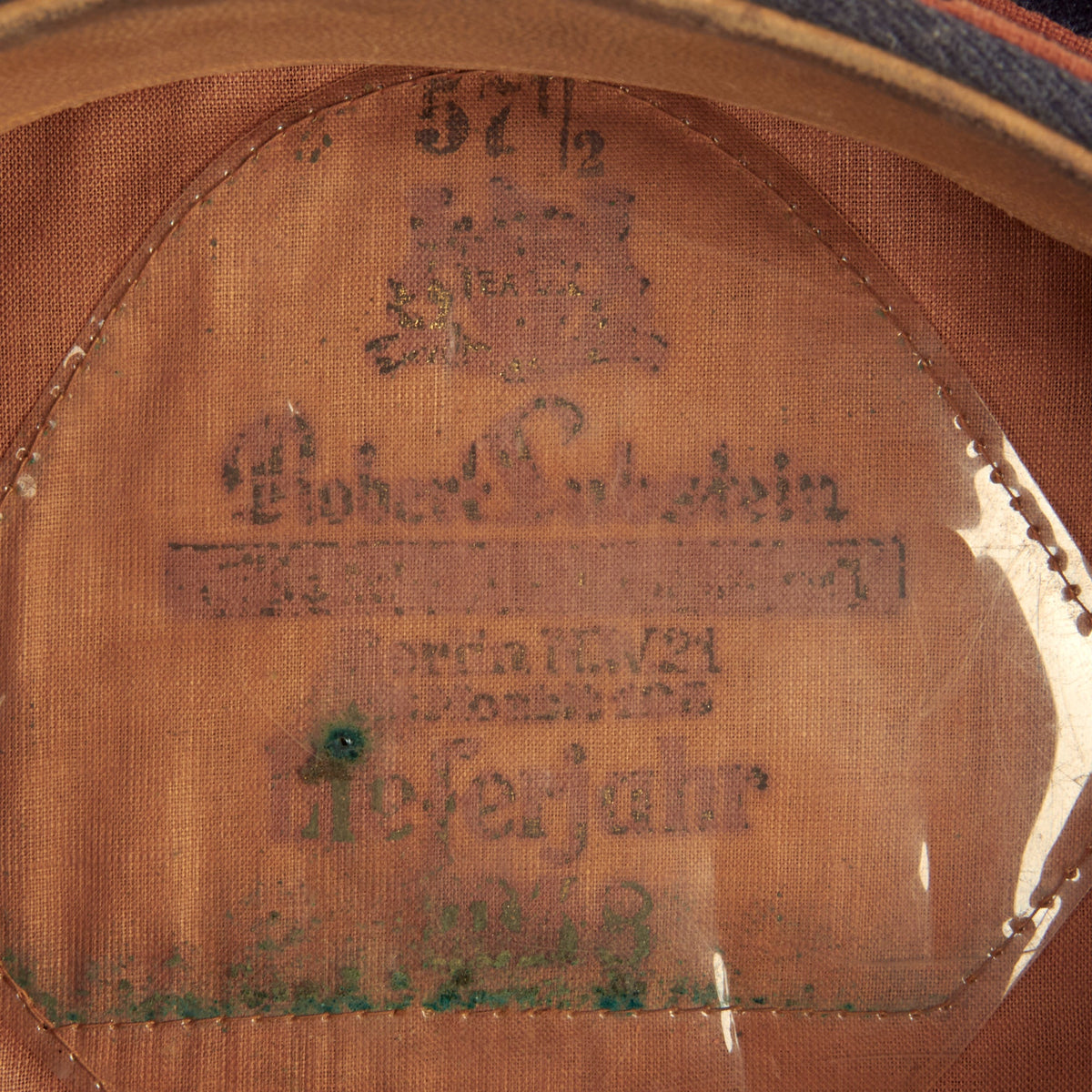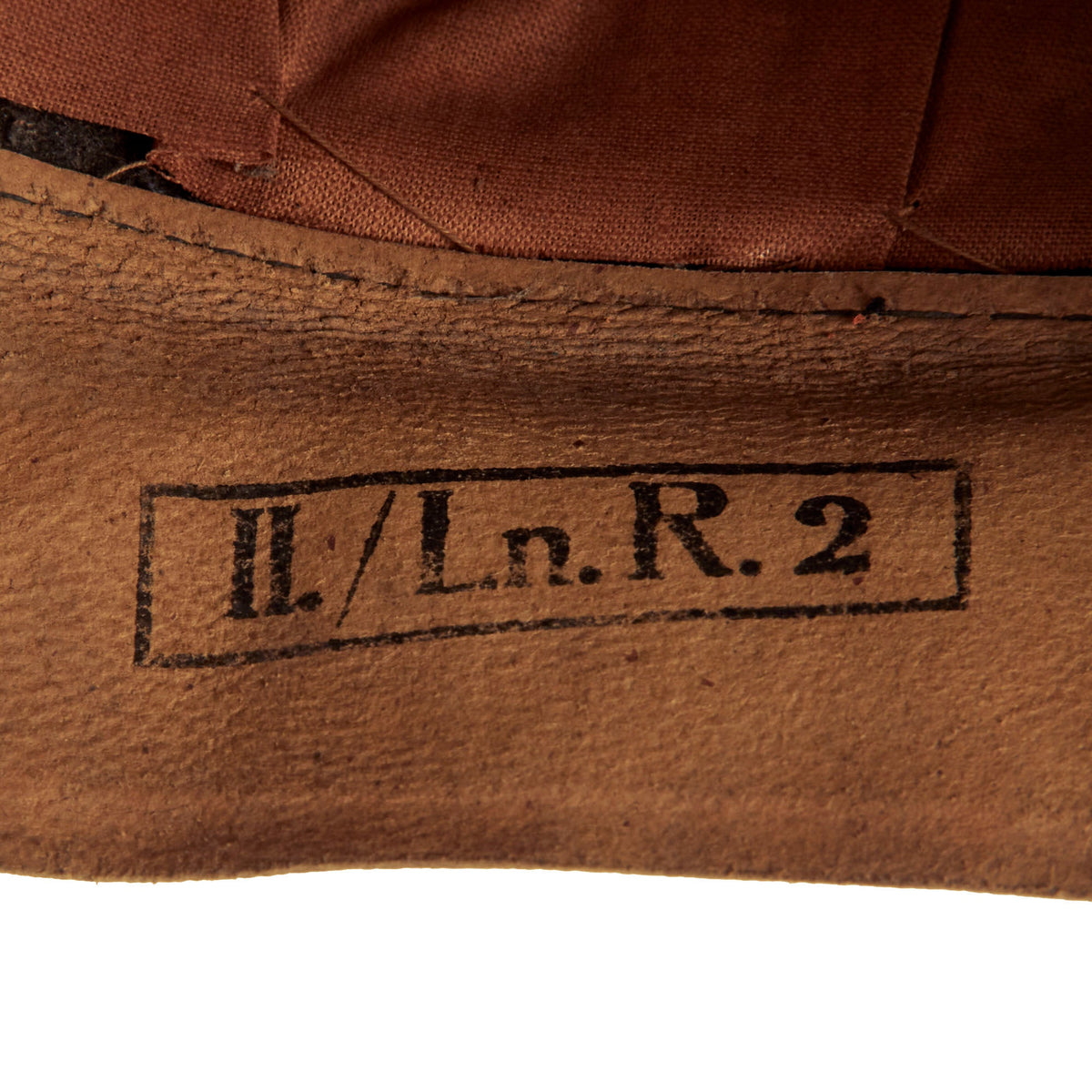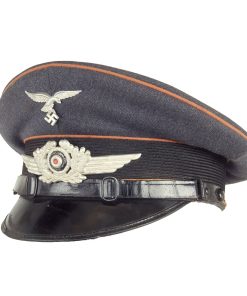Original German WWII Luftwaffe Signals 57 1/2cm EM/NCO Schirmmütze Visor Cap by EREL with Unit Marking – dated 1938 Original Items
$ 695,00 $ 208,50
Original Item: Only One available. This is a very nice lightly used condition Luftwaffe Signals EM/NCO Schirmmütze (Visor Cap), made by the very desirable EREL company, a top class maker of headwear during the war. It still has the original crown stiffener installed, so the sides have not sunken down much over the years, giving it a great gently swept back look. This NCO Schirmmütze Visor Cap is an original high quality manufactured cap. It is fabricated in Luftwaffe blue gray Fliegerblau (Flier’s Blue) “whipcord weave’ wool, with wide black wool cap band, plus three rows of saddle brown (braun) color piping around the circumference. This is the Luftwaffe Waffenfarbe (corps color) for the Air communications corps (Luftnachrichtentruppe), usually referred to as “Signals”.
The is decorated with the correct metal insignia, including a finely-detailed aluminum eagle on the peak, and an aluminum oak leaf wreath with stylized wings and central painted tri-color cockade on the band. The dual-buckled black leather chinstrap, designating the wearer to be an enlisted man, is attached to black lacquered buttons on either side. The visor is the classic gloss black color with a faux stitched edge trim, made of pressed vulcanfibre, with a green underside. There is some great fine checking and age crazing on the top of the visor, confirming the age of the piece. The visor is still solidly attached to the body of the cap, however the edge trim has had the stitching pop on the bottom side in many areas.
The interior of the cap is lined with light brown “service cloth” type material, showing very little in the way of staining or wear. The top celluloid sweat shield is fully intact with great stitching, and it shows a partly legible maker logo under size 57 1/2:
EREL
[SONDERLKLASSE]
Robert Lubstein
[Größte Berliner Militär Mützen Fabrik]
Berlin N.W.21
Alt. Moabit 105
Lieferjahr
1938
The maker information is made from silver paint, which has mostly fallen off and now oxidized into verdigris under the shield. Most lines can still be read however. “Lieferjahr” translates to “Delivery Year”, so that is when the cap was slated to be delivered to the Luftwaffe. Robert Lubstein was a very well known distributor of caps, and was particularly known for retailing their trademark EREL brand headgear.
The sweatband is tan leather, and in very good condition, still supple, showing moderate wear and staining from service. There is a tear near the securing rivet, but otherwise there is no major damage. On the underside of the leather, it is stamped with unit number II. / Ln. R. 2, which we assume would be for the 2nd Company, Luftnachrichten (Signal Intelligence) Regiment 2. Definitely some great research potential here!
This is a very nice Luftwaffe Signals EM/NCO peaked visor cap with some great markings, offered in very good service used condition. Ready to research and display!
The German Schirmmütze Visor Cap:
The visor cap (Schirmmütze) was an important part of the headgear worn by German uniformed military, civil, paramilitary and political organizations during the Third Reich. This was the standard cloth headgear worn as a part of the service uniform. Visor caps were worn outdoors as well as indoors, and were often required to be worn by all personnel on duty. Visor caps were made in versions specific to each organization and were often further differentiated through the use of insignia, colored piping, or style of chin cord, to indicate rank, role or branch. The insignia used on these caps ranged from simple stamped metal emblems, to elaborate hand embroidery. Visor caps were issued to enlisted soldiers and NCOs in the military and in some other organizations. Officers had to purchase their own hats, and lower ranks could choose to purchase caps that were of a higher quality than the rather basic, issue examples. The private purchase caps were generally made in very high quality, with fine materials. A wide variety of fabrics were used, from Trikot and doeskin, to heavy wool, or even lightweight white fabric for summer wear. In the military, issue of these caps was generally suspended shortly after the outbreak of the war, but they continued to be worn by some troops until the end of the war.
Fast Shipping with Professional Packaging
Thanks to our longstanding association with UPS FedEx DHL, and other major international carriers, we are able to provide a range of shipping options. Our warehouse staff is expertly trained and will wrap your products according to our exact and precise specifications. Prior to shipping, your goods will be thoroughly examined and securely secured. We ship to thousands clients each day across multiple countries. This shows how we're dedicated to be the largest retailer on the internet. Warehouses and distribution centres can be located throughout Europe as well as the USA.
Note: Orders with more than one item will be assigned a processing date depending on the item.
Before shipping before shipping, we'll conduct a thorough inspection of the items you have ordered. Today, the majority of orders will be delivered within 48 hours. The delivery time will be between 3-7 days.
Returns
The stock is dynamic and we cannot completely manage it because multiple stakeholders are involved, including our factory and warehouse. So the actual stock may alter at any time. It's possible that you may not receive your order once the order has been made.
Our policy is valid for a period of 30 days. If you don't receive the product within 30 days, we are not able to issue a refund or an exchange.
You can only return an item if it is unused and in the same state as the day you received it. You must have the item in its original packaging.
Related products
Uncategorized
Uncategorized
Uncategorized
Uncategorized
Uncategorized
Uncategorized
Uncategorized
Uncategorized
Uncategorized
Armoured Fighting Vehicles of the World: AFVs of World War One (Hardcover Book) New Made Items
Uncategorized
Uncategorized
Armored Burgonet Helmet & Polearm from Scottish Castle Leith Hall Circa 1700 Original Items
Uncategorized
Uncategorized
Angolan Rebel 1970s era 60mm Inert Display Mortar from Angolan Civil War Original Items
Uncategorized
Uncategorized
Uncategorized
Uncategorized
Uncategorized
Australian WWII Owen MK1 Machine Carbine SMG Custom Fabricated Replica with Sling Original Items
Uncategorized

